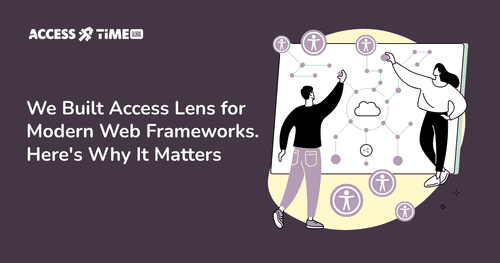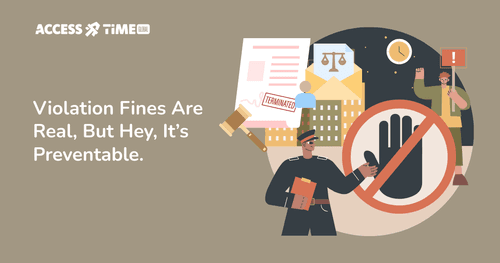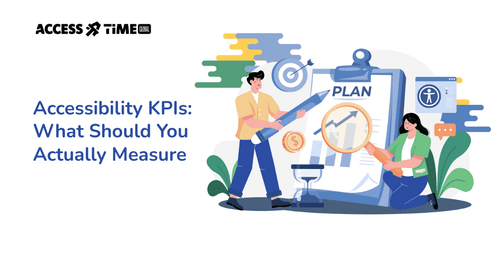We Built Access Lens for Modern Web Frameworks. Here's Why It Matters
Prasaja Mukti - Accessibility UX Writer
●●
If you've ever tried running a traditional accessibility scanner on a React application with dynamic content, you know the frustration. The tool confidently declares your site "accessible," while users with disabilities struggle to navigate components that load asynchronously or interact with complex state management.
Sound familiar?
This isn’t because the tools are “wrong.” It’s because by design, automated accessibility tools can only detect around 20–30% of accessibility issues. That’s a limitation of the current state of automation, not of the teams building these tools.
At Access Lens (beta), we’re building on top of this reality. Even when our reports show zero detected issues, we make it clear: no tool can cover 100% of accessibility problems. Our mission is to push beyond what’s currently possible by covering more of the dynamic, framework-specific challenges that developers face every day, while always reminding teams that accessibility testing is never fully automated.
The Legacy Tool Problem
Most accessibility testing tools were designed for a simpler web. Picture the internet circa 2010 with static HTML pages, minimal JavaScript, and straightforward server-side rendering. These tools worked well when websites were essentially digital brochures with some basic interactivity.
Fast-forward to today's web landscape. We're building sophisticated applications with React, Vue, Angular, and other modern frameworks. Our interfaces are dynamic, component-based, and heavily interactive. Content loads on demand, state changes trigger UI updates, and user experiences are increasingly complex.
Traditional tools aren’t useless here, they still provide valuable checks, and many of us (including Access Lens) stand on their shoulders. But because they focus on the initial DOM snapshot, they often miss issues tied to component lifecycles, lazy loading, or state changes.
This doesn’t mean they’re misleading teams. It just means that the scope of what they cover is naturally limited. For developers working in modern frameworks, this gap can make accessibility fixes harder to identify and slower to resolve.
Where Traditional Tools Fall Short
Let’s imagine you’ve crafted a stunning React dashboard with user-friendly components. Your trusted scanner kicks in, performs a thorough initial render, and gives you a glowing report. But guess what it overlooked?
- The modal that loses focus when it opens
- The data table that doesn't announce updates to screen readers
- The form validation that only shows visual error indicators
- The loading states that leave keyboard users stranded
- These aren't edge cases, they're common patterns in modern web applications.
The result?
Development teams may think they’re covering accessibility thoroughly, when in reality some framework-specific issues remain invisible to their tools, this is about the limits of automation. Without tooling that speaks the same language as their codebase, developers are left with generic reports that don’t translate well into actionable fixes.
The Modern Framework Challenge
Today's web frameworks bring incredible capabilities, but they also introduce new accessibility challenges that legacy tools weren't designed to handle:
- Component Lifecycle Issues: Modern frameworks manage component mounting, updating, and unmounting in ways that can break accessibility features. Focus management becomes complex when components appear and disappear dynamically.
- State Management Complexity: When application state changes, accessibility properties need to update accordingly. Traditional tools can't track these state-dependent accessibility requirements.
- Virtual DOM Challenges: Frameworks like React use virtual DOM diffing, which can cause accessibility announcements to be missed or duplicated.
- Bundle Splitting and Lazy Loading: Code splitting means accessibility features might not be present when traditional scanners run their analysis.
The team at ICSE found that applications built with modern frameworks had more accessibility issues related to dynamic content compared to traditional websites, yet existing testing tools caught only fraction of these framework-specific problems.
Why Access Lens Takes a Different Approach
We built Access Lens specifically for this modern web reality. Instead of retrofitting old scanning techniques, we designed our approach from the ground up to understand how modern frameworks actually work.
AccessLens integrates directly with your development workflow and framework ecosystem. For example, it understands React's component lifecycle, Vue's reactivity system, and Angular's change detection. When your component state changes, Access Lens tracks how those changes affect accessibility.
Our AI-powered insights also works beyond flagging technical violations, they understand the user experience implications. For example, when Access Lens detects a modal component, it doesn't just check if it has the right ARIA attributes. It simulates the actual user journey.
- Can keyboard users reach it?
- Will screen readers announce it properly?
- Is focus managed correctly throughout the interaction?
The Business Impact
When your accessibility testing actually matches your development approach, several things happen:
- Developers catch issues earlier in the development process
- QA cycles become more efficient and reliable
- Post-deployment accessibility complaints drop significantly
- Teams gain confidence in their accessibility implementations
More importantly, the end result is genuinely accessible applications that work for all users, not just applications that pass legacy scanner tests.
Building for the Future, with the Future Tools
The web continues to evolve rapidly. New framework patterns, emerging web standards, and changing user expectations mean accessibility tooling needs to evolve too. Access Lens is designed to grow with these changes, continuously updating our understanding of framework patterns and accessibility best practices.
We're not just building a better scanner, we're building a platform that understands modern web development and helps teams create inclusive experiences that actually work.
Ready to Experience the Difference?
If you're tired of accessibility tools that don't understand your modern tech stack, we'd love to show you what's possible.
Try Access Lens (Beta): Experience AI-powered accessibility insights designed for modern web frameworks. It's completely free while we're in beta, and you'll get early access to features specifically built for React, Vue, Angular, and other modern frameworks.
Need Expert Guidance? Contact our accessibility experts at AccessTime for personalized consultancy. Our team combines deep technical expertise with real-world accessibility experience to help you build truly inclusive applications.
Ready to see the difference? Let's build a more accessible web together.
Contact Us
Ready to explore how accessibility can transform your products? Visit our contact page to learn more about AccessTime consultancy services, or try Access Lens to get started with a fresh perspective on what's possible.
Share:

